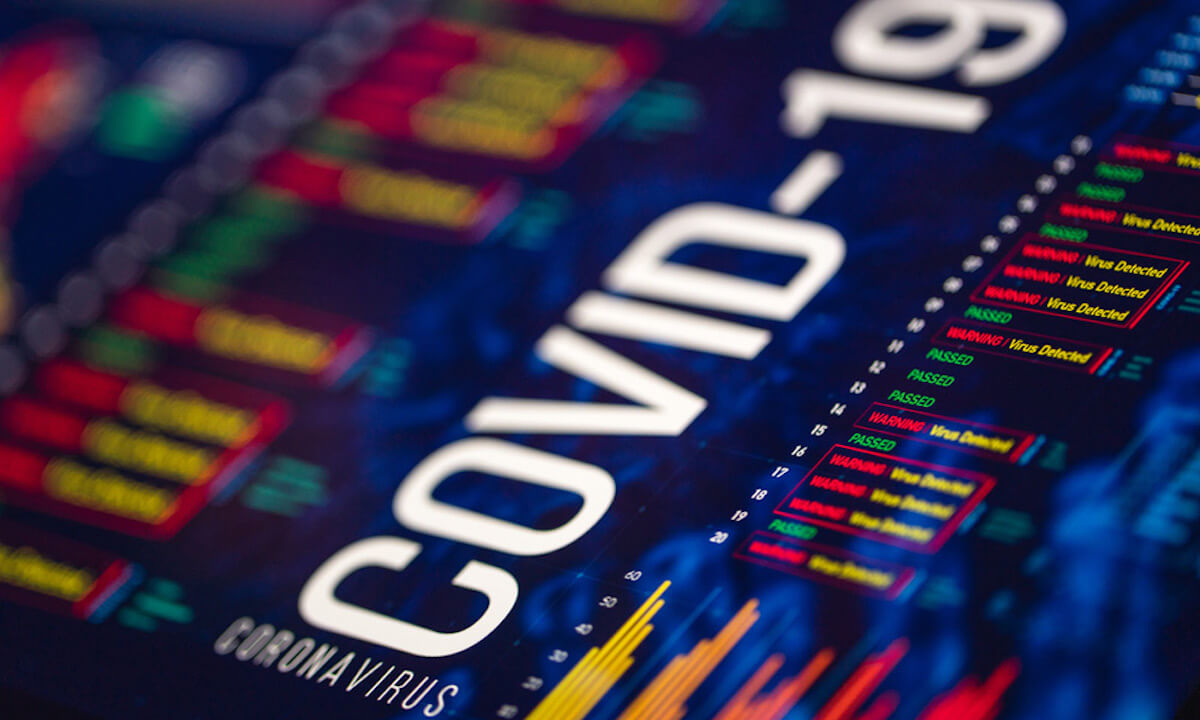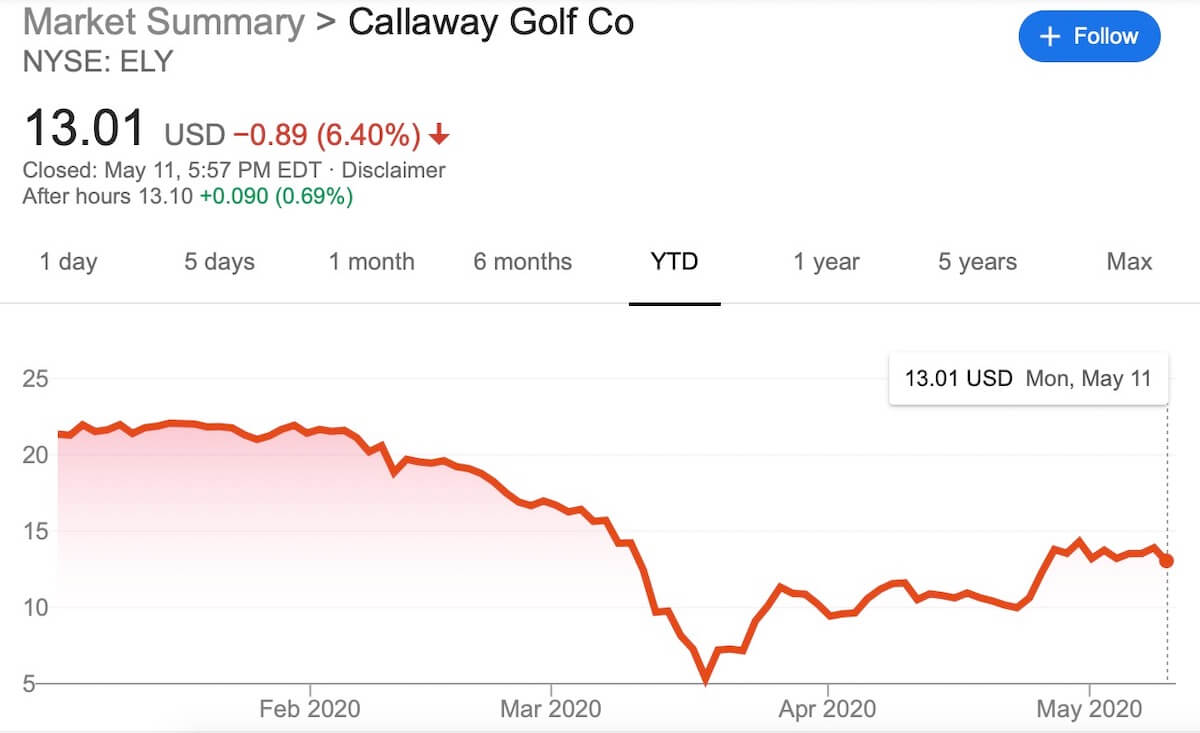Golf’s two biggest companies are making official what everyone already knew: COVID-19 sucks. The Callaway and Acushnet first-quarter financial reports share fascinating insights into how each company dealt with the early uncertainty of the pandemic.
And both show how the virus derailed promising starts to 2020 and how neither company is really sure what the coming months will bring.
Just like the rest of us.
Please keep in mind we are not, nor are we claiming to be, financial advisors or investment counselors. We’re just guys who like to read. That said, the results are about what you’d expect. Sales and profits are down and both companies are gearing up for a bumpy ride.
Both reported strong starts to the year and both posted net profits for Q1. But the sobering truth of the Callaway and Acushnet first-quarter financial reports is that by mid-March quarterly projections went out the window.
Callaway Financials
Callaway finally wrestled the title of “Golf’s Top Dog” away from Acushnet in 2019. But despite a strong start, Callaway’s Q1 net sales are down 14 percent compared to Q1 2019 ($442 million versus $516 million). Specifically, club sales dropped by four percent and ball sales dropped by 35 percent. Apparel sales dropped by 20 percent and gear (bags, gloves, accessories) dropped by 24 percent.
Overall, Callaway still turned a $29-million net profit in Q1. However, that’s down more than 40 percent from the $49-million net profit recorded in Q1 last year. As you’d expect, the press release put as positive spin on the results as it could.
“We are pleased that during the first quarter of 2020 our golf equipment market shares remained strong in all our major markets,” says Callaway CEO Chip Brewer. “We were able to deliver a profitable quarter despite the negative impact of COVID-19.”
U.S. sales dropped by 12.6 percent in Q1 while in Europe sales dropped by nearly 24 percent. Sales in Japan, however, were up 5.6 percent but the rest of the world was down by 25 percent.
Like other major OEMs, Callaway instituted cost-cutting measures in March. The Q1 report indicates a $14-million reduction in operating expenses due to reduced sales. Costs related to the Jack Wolfskin acquisition were also cleared from the books. Callaway has instituted layoffs, furloughs, and pay cuts but it’s unclear whether costs associated with those reductions were allocated in Q1.
In April, Callaway announced Brewer would forego his $900,000 base salary amid the pandemic. Brewer’s total compensation for 2019 was an estimated $5.8 million in salary, bonuses, and stock options.
Other Callaway senior management, as well as its board of directors, are also giving up their pay.
Cash is King
In business, you can ride out rough seas if you have cash. To that end, Callaway issued and sold $250-million worth of convertible senior notes in Q1. The proceeds are earmarked for working capital and general corporate purposes. The notes were offered to qualified institutional buyers and will accrue interest at a rate of 2.75 percent annually. They’re payable in 2026.
“Having this additional liquidity will not lessen our resolve for, and we remain committed to, maintaining our disciplined approach to managing capital and expenses,” says Brewer. “We believe this additional liquidity, together with the strength of our brands, our product, and geographic diversity, and the operational improvements we have made to date, will enable us to create shareholder value as we emerge from this pandemic.”
Callaway specifically listed COVID-19 as a potential business threat in its 2019 annual report. While the report focused on supply chain disruption in Asia, it did issue an all-purpose warning.
“The impact of the virus varies from region to region and from day to day, and any significant spreading of the virus could exacerbate the effect on the company’s business. The outbreak is likely to have a further impact in 2020 on the global economy, the company’s ability to manufacture its products for sale globally, and on the demand for consumer products.”
Callaway stock hovered at around $22 per share in January but tumbled to a low of $5.34 on March 18. It has rebounded somewhat and is currently at $13 per share.
Acushnet Q1 Financials
Titleist’s’ parent company also cited COVID-19 as a possible threat to its 2020 business. However, it’s well down the list of possibilities, along with natural disasters.
Acushnet’s Q1 report shows sales are down only six percent compared to Q1 2019 ($408 million versus $434 million). Not bad, considering. First-quarter net profits might be of bigger concern: $8.9 million compared to $45 million last year.
That’s a nearly 75-percent drop. For a business as steady and consistent as Acushnet, that might be shocking. But then again, for a business as steady and consistent as Acushnet, there’s most likely an explanation.
Interestingly, club sales jumped two percent in Q1, largely due to the new Vokey SM8 wedges and Scotty Cameron Special Select putters. Ball sales, however, dropped 18 percent ($116 million versus $143 million last year). FootJoy, as well, fell nearly eight percent ($130 million versus $141 million). Titleist gear (bags, hats, other accessories) dropped four percent.
“Asia markets were impacted first by the crisis and are at varying stages of recovery,” says Acushnet CEO David Maher. “North America and Europe were affected in March and … our businesses there have been significantly impacted.”
Specifically, the U.S. region is down more than eight percent, Japan 7.6 percent, and what Acushnet calls the Rest of the World, nearly 18 percent. Korean business is up three percent. Europe is actually up five percent but that’s largely due to new KJUS business. Acushnet acquired KJUS, a Swiss-based supplier of high-end golf, ski and outdoor wear, last summer.
Acushnet stock started the year at nearly $33 per share. It fell to $21.15 on March 23 and is back up to nearly $29 now.
Shutdowns and Furloughs
Titleist’s ball plants in Massachusetts remain shut and Acushnet has furloughed factory and assembly workers there and in Carlsbad. Acushnet’s income statement reflects reductions in both fixed and variable overhead.
Despite only $8.9 million in net profit, Acushnet showed $53 million in EBITDA, compared to $64 million last year. That’s an understandable 17-percent dollar decrease year over year. However, it’s only a 13-percent decrease in EBITDA margin year over year
EBITDA is “Earnings Before Interest, Taxes, Depreciation, and Amortization” and basically reflects the relative health of sales versus expenses management can control. Callaway’s EBITDAS (the S is for non-cash stock compensation expenses) for Q1 was $58 million, compared to $79 million last year, a nearly 27-percent drop.
Two key offsets included in Acushnet’s Q1 EBIDTA report include restructuring charges and what’s called “other extraordinary, unusual or non-recurring items.” According to the report, restructuring charges include severance and other costs associated with “management’s approved restructuring program.” Extraordinary, unusual or non-recurring items include “salaries and benefits paid for associates who could not work due to government-mandated shutdowns (and) fringe benefits paid for furloughed associates.” Spoiled raw materials, incremental costs to support remote work, and additional health and safety equipment are also included.
Those offsets total nearly $20 million. That indicates Acushnet’s lower net profit may very well be due to when and how certain expenses are allocated. When reviewing each company’s P&L statements, Callaway’s Selling, General, and Administrative expenses are nearly $11 million lower than Acushnet’s.
Acushnet also donated 100,000 masks to local hospitals and has manufactured PPE for front-line health-care workers. The company has held charity auctions and donated a portion of online sales to relief efforts, totaling more than $800,000.
Final Thoughts:
So, what do the Callaway and Acushnet first-quarter financial reports tell us? Acushnet included this interesting passage from Simon Sinek’s book The Infinite Game in its 2019 annual report:
“The game of business fits the very definition of an infinite game. There is no finish line, no practical end to the game. And when everyone focuses on the infinite vision, it not only drives innovation, it also drives up the numbers. What’s more, the inspiration, innovation, cooperation, brand loyalty and profits that result from infinite minded leadership serve companies not just in times of stability but also in times of instability. A company built for resilience is a company that is structured to last forever.”
Acushnet and Callaway are nothing if not resilient. And nothing tests resiliency like a three-month hiatus during the prime selling season. Callaway is being proactive by cutting expenses and – in its words – aggressively decreasing inventory commitments. That means Callaway has either canceled or postponed component orders from its suppliers. Acushnet is also watching its worldwide inventories.
What’s more, Callaway says its E-commerce business is exceeding expectations. And as golf retail starts to re-open, Callaway says initial sell-through has been above expectations despite being below last year’s levels. Both companies expect a significant hit in Q2, but neither is hinting at how it might react.
Golfers may be anticipating big discounts on current-year gear but both companies seem to be managing inventory to avoid an overstock situation. What retailers do with stock they’ve already bought, however, is a different story.
So back to the original question: what do the Callaway and Acushnet first-quarter financial reports tell us? Well, pretty much what we already knew. No one really knows what’s going to happen. And COVID-19 sucks.

























Martin
4 years ago
Second and third quarter is going to be tuff. Hopefully EOM will lower club price across the board most consumer can not justify the club prices when new things come out every year and last year model is mark down. 550 for Maverick when the Callaway Epic Flash and just been reduced to 349.00 which was a good pre-forming driver. Just think if the Epic Flash was 349.00-399 when it was introduced how many would have been sold. Next few months it will take one major OEM to drop there pricing because of sales others follow suit.
Mike
4 years ago
Once drivers went way over the $400 mark and fairways way over the $250 mark, I lost interest in paying new club prices,. Maybe the OEM is will have to redesign the business model, maybe focus less on endorsement monies paid out. Not sure if that would drop the price of clubs, but I’ve never ever bought a club, any club, simply because a pro used it. Over the last 20 years, only Tiger influenced club buying in that manner.. And that was then. We find thousands of balls in our hazards very few bridgestones. So the Tiger effect has not translated into selling tons more bridgestone balls.